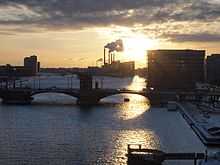H. C. Ørsted Power Station
| H. C. Ørsted Power Station | |
|---|---|
 H. C. Ørsted power station viewed from the water | |
 Location of H. C. Ørsted Power Station in Denmark Copenhagen | |
| Country | Denmark |
| Location | Enghave Brygge |
| Coordinates | 55°39′24.67″N 12°33′25.07″E / 55.6568528°N 12.5569639°ECoordinates: 55°39′24.67″N 12°33′25.07″E / 55.6568528°N 12.5569639°E |
| Status | Operating |
| Construction began | 1916 |
| Commission date | 1920 (1924 and 1930-1932) |
| Owner(s) |
Københavns Belysningsvæsen (1920-2001) Københavns Energi (2001-2006) Dong Energy (2006-present) |
| Thermal power station | |
| Primary fuel |
Coal (1820-1994) natural gas (1994-present) |
| Cogeneration? | yes |
| Power generation | |
| Thermal capacity | 815 MJ/s |
| Nameplate capacity | 185 |
|
Website Official website | |
H. C. Ørsted Power Station (Danish: H. C. Ørstedværket) is a natural gas fired combined heat and power station located at Enghave Brygge, Sydhavnen in Copenhagen, Denmark. It is owned and operated by Dong Energy.
It is named after the Danish physicist Hans Christian Ørsted, the discoverer of electromagnetism.
History

Copenhagen's first three power stations, Gothersgade Power Station from 1892 and the Western and Easter Power Stations from 1898 and 1901, all operated by Københavns Belysningsvæsen, used direct current technology which required a location close to the consumers.[1] The introduction of alternating current technology made it possible to build larger plants at less central locations and H. C. Ørsted Power Station, designed by Andreas Fussing, was built between 1916 and 1920 on Kalvebod Beach to the south of the city. The location by the sea and close to the Southern Harbour provided easy access to cooling water and coal-loading facilities.
On its completion it became the largest power station in Denmark, a position it kept until 1940. It had enough capacity to supply all of the Copenhagen area with lighting, reducing the three existing power stations to back-up systems and transformer stations.[1]
The power station was expanded and adapted in 1924 and again between 1930 and 1932 by Louis Hygom and Valdemar Schmidt. The 1932 expansion saw the installation of a gigantic Burmeister & Wain diesel engine which held the position as the world's largest diesel engine for about 30 years.[2]
Coal remained the principal source of fuel until 1994 when it was converted into a natural gas-fired power station.[3]
Architecture
The building is red-washed with tall slender windows and blue chimneys. It has been designated as one of 25 Danish Industrial Heritage Site by the Danish Heritage Agency.[4]
Technical description
Today the primary task of the power station is to supply district heating to district-heating network of Greater Copenhagen. Its capacity is 185 MW electricity and 815 MJ/s district heating.[3]
References
- ↑ 1.0 1.1 "H. C. Ørstedsværket" (in Danish). Kulturarvsstyrelsen. Retrieved 2011-09-12.
- ↑ "Between diesel engines and other machines". Copenhagen X. Retrieved 2011-09-12.
- ↑ 3.0 3.1 "H H.C. Ørsted Power Station". Dong Energy. Retrieved 2012-12-08.
- ↑ "25 nationale industriminder" (in Danish). DR. Retrieved 2011-09-12.
External links
| Wikimedia Commons has media related to H. C. Ørstedværket. |
- DONG Energy, official website
| ||||||||||||||||||||||||||||||||||||||||